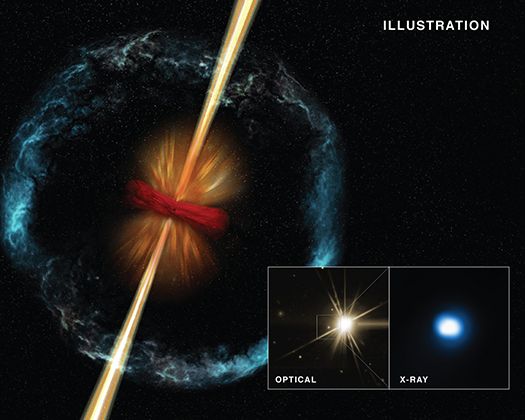Chandra Finds Evidence for Violent Stellar Merger

Gamma-ray bursts, or GRBs, are some of the most violent and energetic events in the Universe. Although these events are the most luminous explosions in the universe, a new study using NASA's Chandra X-ray Observatory, NASA's Swift satellite and other telescopes suggests that scientists may be missing a majority of these powerful cosmic detonations.
Astronomers think that some GRBs are the product of the collision and merger of two neutron stars or a neutron star and a black hole. The new research gives the best evidence to date that such collisions will generate a very narrow beam, or jet, of gamma rays. If such a narrow jet is not pointed toward Earth, the GRB produced by the collision will not be detected.
Collisions between two neutron stars or a neutron star and black hole are expected to be strong sources of gravitational waves that could be detected whether or not the jet is pointed towards the Earth. Therefore, this result has important implications for the number of events that will be detectable by the Laser Interferometry Gravitational-Wave Observatory (LIGO) and other gravitational wave observatories.
On September 3, 2014, NASA's Swift observatory picked up a GRB - dubbed GRB 140903A due to the date it was detected. Scientists used optical observations with the Gemini Observatory telescope in Hawaii to determine that GRB 140903A was located in a galaxy about 3.9 billion light years away, relatively nearby for a GRB.
The large panel in the graphic is an illustration showing the aftermath of a neutron star merger, including the generation of a GRB. In the center is a compact object - either a black hole or a massive neutron star - and in red is a disk of material left over from the merger, containing material falling towards the compact object. Energy from this infalling material drives the GRB jet shown in yellow. In orange is a wind of particles blowing away from the disk and in blue is material ejected from the compact object and expanding at very high speeds of about one tenth the speed of light.
The image on the left of the two smaller panels shows an optical view from the Discovery Channel Telescope (DCT) with GRB 140903A in the middle of the square and a close-up X-ray view from Chandra on the right. The bright star in the optical image is unrelated to the GRB.
The gamma-ray blast lasted less than two seconds. This placed it into the "short GRB" category, which astronomers think are the output from neutron star-neutron star or black hole-neutron star collisions eventually forming either a black hole or a neutron star with a strong magnetic field. (The scientific consensus is that GRBs that last longer than two seconds result from the collapse of a massive star.)
More information at http://chandra.si.edu/photo/2016/grb/index.html
-Megan Watzke, CXC
Please note this is a moderated blog. No pornography, spam, profanity or discriminatory remarks are allowed. No personal attacks are allowed. Users should stay on topic to keep it relevant for the readers.
Read the privacy statement
